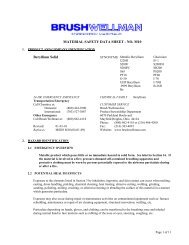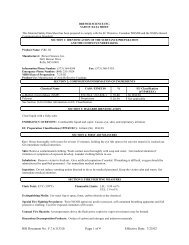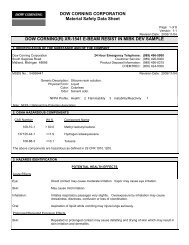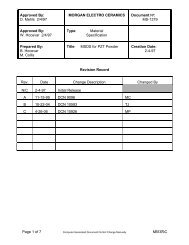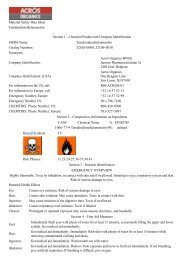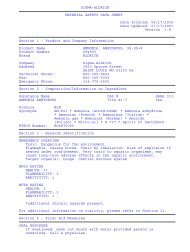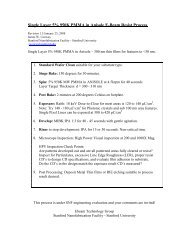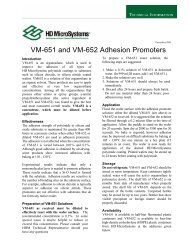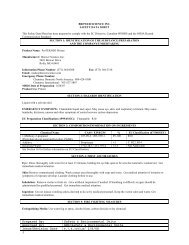Dow Corning® WL-5150
Dow Corning® WL-5150
Dow Corning® WL-5150
Create successful ePaper yourself
Turn your PDF publications into a flip-book with our unique Google optimized e-Paper software.
<strong>Dow</strong> Corning Proprietary<br />
Revised April, 2004<br />
<strong>Dow</strong> Corning ® <strong>WL</strong>-<strong>5150</strong><br />
Photodefinable Spin-On<br />
Silicone<br />
Properties and Processing Procedures<br />
Introduction<br />
<strong>Dow</strong> Corning ® <strong>WL</strong>-<strong>5150</strong> is a silicone<br />
formulation which can be photopatterned<br />
and cured using standard microelectronics<br />
processing techniques. The silicone material<br />
is prepared in mesitylene with a solution<br />
viscosity of 450 cP. The standard method for<br />
application of <strong>Dow</strong> Corning ® <strong>WL</strong>-<strong>5150</strong> is<br />
by spin coating although other methods of<br />
application (such as spray coating and<br />
extrusion coating) may also be applicable.<br />
Application, patterning and cure of <strong>Dow</strong><br />
Corning ® <strong>WL</strong>-<strong>5150</strong> is accomplished in a<br />
simple six-step process that utilizes<br />
commercially available equipment. Updated<br />
information on the processing of the <strong>Dow</strong><br />
Corning ® <strong>WL</strong>-<strong>5150</strong> materials is available<br />
from your local <strong>Dow</strong> Corning<br />
representative.<br />
Material Properties<br />
<strong>Dow</strong> Corning ® <strong>WL</strong>-<strong>5150</strong> can be solvent cast<br />
to form free standing monoliths or spincoated<br />
onto substrates to form sub 50 µm<br />
thick films. The mechanical properties of<br />
<strong>Dow</strong> Corning ® <strong>WL</strong>-<strong>5150</strong> thin film (20 µm)<br />
and bulk samples (~ 2 mm thickness) are<br />
listed in Table 1 for samples cured at 250°C<br />
for 30 minutes.<br />
The room temperature modulus of <strong>Dow</strong><br />
Corning ® <strong>WL</strong>-<strong>5150</strong> has been measured by a<br />
continuous stiffness (CSM) nanoindentation<br />
technique on spin-coated thin films. Figure 1<br />
shows a typical modulus vs. displacement<br />
curve for a 20 µm thick film of <strong>Dow</strong><br />
Corning ® <strong>WL</strong>-<strong>5150</strong> cured at 250°C for 30<br />
minutes. The plot shows the change in the<br />
modulus as the indenter tip penetrates into<br />
the film surface up to a maximum<br />
penetration depth of 2200 nm.<br />
Modulus (GPa)<br />
1<br />
Mechanical Property Value<br />
Nanoindentation Modulus (MPa) 301<br />
Nanoindentation Hardness<br />
(MPa)<br />
9.5<br />
Film Residual Stress on Si<br />
Wafer (MPa)<br />
2.6<br />
Bulk Modulus (MPa at 25°C) 160<br />
Bulk Tensile Strength (MPa) 6.0<br />
Bulk Elongation (%) 37.6<br />
CTE (ppm/°C) 236<br />
Table 1. Mechanical properties of <strong>Dow</strong><br />
Corning ® <strong>WL</strong>-<strong>5150</strong>.<br />
0.8<br />
0.7<br />
0.6<br />
0.5<br />
0.4<br />
0.3<br />
0.2<br />
0.1<br />
0<br />
0 500 1000 1500 2000 2500<br />
Displacement Into Surface (nm)<br />
Figure 1. Modulus vs. displacement curve<br />
for <strong>Dow</strong> Corning ® <strong>WL</strong>-<strong>5150</strong> (frequency =<br />
75 Hz).<br />
<strong>Dow</strong> Corning ® <strong>WL</strong>-<strong>5150</strong> provides a low<br />
modulus, low stress film after cure with a<br />
film surface modulus of approximately 300<br />
MPa. The increase in modulus with indenter<br />
displacement into the film is due an<br />
increasing substrate effect with penetration.<br />
The dimensional change of <strong>Dow</strong> Corning ®<br />
<strong>WL</strong>-<strong>5150</strong> as a function of temperature is<br />
shown in Figure 2. A linear expansion is<br />
observed throughout the temperature region<br />
of –100 to 300°C.<br />
The thermal stability characteristics of <strong>Dow</strong><br />
Corning ® <strong>WL</strong>-<strong>5150</strong> cured at 250°C for 30<br />
minutes are listed in Table 2. Good thermal<br />
stability and modulus retention have been<br />
demonstrated to a temperature of 300°C.
<strong>Dow</strong> Corning Proprietary<br />
Revised April, 2004<br />
Dimension Change (µm/m)<br />
1e+5<br />
8e+4<br />
6e+4<br />
4e+4<br />
2e+4<br />
0<br />
-100 -50 0 50 100 150 200 250 300<br />
Figure 2. Dimension change vs. temperature<br />
for <strong>Dow</strong> Corning ® <strong>WL</strong>-<strong>5150</strong>.<br />
Condition Weight Loss (%)<br />
Isothermal at<br />
1.9<br />
250°C/60 minutes<br />
Isothermal at<br />
3.5<br />
300°C/60 minutes<br />
Dynamic to 250°C<br />
1.0<br />
(10°C/minute)<br />
Dynamic to 300°C<br />
1.7<br />
(10°C/minute)<br />
Table 2. Thermal stability characteristics for<br />
<strong>Dow</strong> Corning ® <strong>WL</strong>-<strong>5150</strong>.<br />
The weight loss profile for <strong>Dow</strong> Corning ®<br />
<strong>WL</strong>-<strong>5150</strong> is shown in Figure 3 for a sample<br />
cured at 250°C for 30 minutes.<br />
Weight Percent Remaining<br />
102<br />
100<br />
98<br />
96<br />
94<br />
92<br />
90<br />
88<br />
86<br />
84<br />
82<br />
80<br />
0<br />
0 20 40 60 80 100 120<br />
Time (minutes)<br />
600<br />
500<br />
400<br />
300<br />
200<br />
100<br />
Figure 3. Thermal weight loss for a<br />
250°C/30 minute cured <strong>Dow</strong> Corning ® <strong>WL</strong>-<br />
Temperature (°C) (°C)<br />
Percent Transmittance<br />
Cured films of <strong>Dow</strong> Corning ® <strong>WL</strong>-<strong>5150</strong><br />
show excellent optical transparency down to<br />
a wavelength of 220 nm. The UV-visible<br />
spectrum for a 24 µm thick 250°C cured<br />
film on a quartz substrate is shown in Figure<br />
4.<br />
The electrical properties and moisture<br />
absorptivity for <strong>Dow</strong> Corning ® <strong>WL</strong>-<strong>5150</strong><br />
are listed in Table 3.<br />
100<br />
90<br />
80<br />
70<br />
60<br />
50<br />
40<br />
30<br />
20<br />
10<br />
0<br />
100 200 300 400 500 600 700 800 900<br />
Wavelength (nm)<br />
Figure 4. UV-visible spectrum for a cured<br />
film of <strong>Dow</strong> Corning ® <strong>WL</strong>-<strong>5150</strong>.<br />
Electrical Property Value<br />
Dielectric Constant (1 MHz) 3.2<br />
Dissipation Factor (1 MHz) 0.007<br />
Leakage Current (A/cm 2 ) 1 x 10 -11<br />
Breakdown Voltage (V/cm) 3.9 x 10 5<br />
PCT Moisture Absorption (%) 0.24<br />
Table 3. Electrical properties and moisture<br />
absorptivity for <strong>Dow</strong> Corning ® <strong>WL</strong>-<strong>5150</strong><br />
measured on monolithic specimens.<br />
Material Shipping and Storage<br />
<strong>Dow</strong> Corning ® <strong>WL</strong>-<strong>5150</strong> is shipped cold<br />
with blue ice at a temperature of<br />
approximately 5°C. If the solution arrives at<br />
its destination warm please contact your<br />
local <strong>Dow</strong> Corning representative. Upon<br />
receipt the solution should be immediately<br />
stored at a temperature of –15°C. Prior to<br />
use the solution should be allowed to<br />
equilibrate to room temperature.<br />
<strong>5150</strong> sample analyzed under helium. During use <strong>Dow</strong> Corning ® <strong>WL</strong>-<strong>5150</strong> should<br />
not be allowed to remain at room<br />
2
<strong>Dow</strong> Corning Proprietary<br />
Revised April, 2004<br />
temperature for more than 3-4 days to<br />
maintain good performance.<br />
Material Waste Handling<br />
In disposing of <strong>Dow</strong> Corning ® <strong>WL</strong>-<strong>5150</strong> or<br />
rinse and developing solvents containing<br />
<strong>Dow</strong> Corning ® <strong>WL</strong>-<strong>5150</strong> it is important that<br />
these do not come into contact with basic<br />
materials (including ammonia, alkyl amines,<br />
ammonium hydroxides, alkyl ammonium<br />
hydroxides, metal hydroxides) as well as<br />
oxidizing metals and oxidizing agents.<br />
These in combination with water can result<br />
in the evolution of hydrogen gas from the<br />
composition. Consult the MSDS provided<br />
for additional information on materials<br />
waste handling.<br />
Processing<br />
A step-by-step summary of processing for<br />
<strong>Dow</strong> Corning ® <strong>WL</strong>-<strong>5150</strong> is presented<br />
schematically in Figure 5 and in Table 4.<br />
1<br />
Spin Coat<br />
2<br />
Soft Bake<br />
3<br />
UV Exposure<br />
4<br />
Post Exposure Bake<br />
5<br />
Solvent Develop<br />
6<br />
Hard Bake (Cure)<br />
Figure 5. Application, patterning and cure<br />
process steps for <strong>Dow</strong> Corning ® <strong>WL</strong>-<strong>5150</strong>.<br />
3<br />
The process consists of six general process<br />
steps to arrive at a cured patterned film. The<br />
target thickness is approximately 22 µm.<br />
Process Step Standard Conditions<br />
1. Spin Coat<br />
a) Spread<br />
b) Spin<br />
c) Edge Bead<br />
500 rpm/10 sec.<br />
500-2500 rpm/30 sec.<br />
1500 rpm/30 sec.<br />
2. Soft-bake Hot Plate<br />
110°C/120 seconds<br />
3. UV Exposure i-line or Broadband<br />
1000 mJ/cm 2<br />
4. Post-exposure<br />
Hot Plate<br />
Bake<br />
150°C/120 sec.<br />
5. Development Stoddard Solvent<br />
Automated<br />
Development Process<br />
(see Step 5 comments)<br />
6. Hard Bake Oven (Air, N2 or<br />
vacuum)<br />
150°C/120 min. or<br />
180°C/60 min. or<br />
250°C/30 min.<br />
Table 4. Processing conditions for <strong>Dow</strong><br />
Corning ® <strong>WL</strong>-<strong>5150</strong>.<br />
Step 1. Coating Process<br />
Surfaces for coating <strong>Dow</strong> Corning ® <strong>WL</strong>-<br />
<strong>5150</strong> should be free of surface impurities<br />
prior to coating. It is recommended that the<br />
spin-coaters used to deposit the solutions be<br />
equipped with a backside rinse capability<br />
and bowl exhaust. The coater should also be<br />
equipped with two dispense heads, one for<br />
dispensing <strong>Dow</strong> Corning ® <strong>WL</strong>-<strong>5150</strong> and a<br />
second for dispensing a solvent for edge<br />
bead removal.<br />
Depending on the size of the substrate<br />
approximately 8-10 mL of <strong>Dow</strong> Corning ®<br />
<strong>WL</strong>-<strong>5150</strong> is applied to a wafer in either<br />
static or dynamic dispense modes. The<br />
wafer speed is then set to 500 rpm for 10<br />
seconds to allow the solution to spread<br />
across the wafer. The speed is then increased<br />
to achieve a uniform film coating across the<br />
wafer. A speed of 1500 rpm is<br />
recommended to achieve a film thickness of
<strong>Dow</strong> Corning Proprietary<br />
Revised April, 2004<br />
approximately 22 µm after full processing<br />
(completion of steps 1-6). Expansion of the<br />
spin speed range between 500 and 3000 rpm<br />
allows for final fully processed film<br />
thicknesses ranging from 40 to 15 µm<br />
respectively. During the spin step it is<br />
recommended that a backside rinse be<br />
implemented to eliminate polymer string<br />
(cotton candy) formation at the wafer edge.<br />
Edge bead removal is conducted by spinning<br />
the wafer at speeds not faster than the spinon<br />
speed and applying mesitylene or a<br />
Stoddard type of solvent (such as Air<br />
Products Negative Resist Developer ® ) to the<br />
topside of the wafer to remove the bead<br />
formed at the wafer edge. The solvent can<br />
be applied using a dispenser or manually by<br />
syringe.<br />
Step 2. Soft-bake<br />
After coating, the film produced from <strong>Dow</strong><br />
Corning ® <strong>WL</strong>-<strong>5150</strong> is subjected to a low<br />
temperature bake to remove residual solvent.<br />
The standard process is to heat the wafer on<br />
a hotplate to a temperature of 110°C for a<br />
period of 2 minutes. After the soft-bake the<br />
film will remain tacky; however, the<br />
tackiness can be reduced by further heating<br />
the film on a hotplate at a temperature of<br />
110°C for up to 5 minutes.<br />
It may be desirable to perform an oven<br />
rather than hotplate soft-bake. Any oven<br />
process will need to be optimized to the<br />
equipment used. If such an approach is used<br />
it is important that the coatings remain in a<br />
horizontal rather than vertical orientation to<br />
avoid a downward flow of the material on<br />
the substrate.<br />
Step 3. UV Exposure<br />
UV-light exposure of films prepared from<br />
<strong>Dow</strong> Corning ® <strong>WL</strong>-<strong>5150</strong> causes the<br />
activation of a photo-sensitive compound in<br />
the formulation that results in selective<br />
cross-linking (setting) of the UV-light<br />
exposed regions during the post-exposure<br />
bake (Step 4). As the photoactivation and<br />
subsequent cross-linking takes place in the<br />
light exposed regions, dissolution and<br />
4<br />
removal of the non-cross-linked regions in<br />
Step 5 results in a negative image of the<br />
original photomask. Films prepared from<br />
<strong>Dow</strong> Corning ® <strong>WL</strong>-<strong>5150</strong> can be exposed to<br />
patterned UV-light using a mask aligner or a<br />
stepper. Due to the surface tackiness of the<br />
films after soft-bake direct contact of the<br />
films with the UV exposure equipment<br />
components must be avoided. For UV-light<br />
exposure using a mask aligner a typical<br />
proximity gap of 20-40 µm is used. It is<br />
recommended that the UV-light exposure be<br />
conducted using either i-line or broadband<br />
radiation. The sensitivity of the films to g-<br />
and h-line radiation is low and exposure at<br />
these wavelengths is not recommended. The<br />
standard dose of broadband UV-light from a<br />
medium pressure Hg lamp for films with a<br />
thickness of 15 to 40 µm is 1000 mJ/cm 2 .<br />
Doses in the range of 600 to 1000 mJ/cm 2<br />
can be used but may result in slightly<br />
reduced film retention. Exposure to doses<br />
lower than 600 mJ/cm 2 will result in low or<br />
no film retention.<br />
Step 4. Post-Exposure Bake<br />
Following Step 3 it is necessary to subject<br />
the film to a post UV-light exposure bake.<br />
Omitting this step will result in the complete<br />
removal of both the irradiated and nonirradiated<br />
portions of the film during the<br />
development step. It is during this step that<br />
the UV-light irradiated portions of the film<br />
undergo a cross-linking process rendering<br />
those areas insoluble in the developing<br />
solvent. The standard condition for the postexposure<br />
bake is placement of the substrate<br />
onto a hotplate at 150ºC for a period of at<br />
least 90 seconds and not exceeding 180<br />
seconds. The standard hot-plate exposure is<br />
150ºC for 120 seconds. Exposure of the film<br />
to a temperature of 150ºC for periods longer<br />
than 180 seconds can result in a significant<br />
increase of film residue (scumming) in the<br />
non-exposed regions. Exposure at 150ºC for<br />
periods less than 90 seconds can result in<br />
insufficient cross-linking and a significant<br />
reduction in the final film thickness after<br />
development.
<strong>Dow</strong> Corning Proprietary<br />
Revised April, 2004<br />
Step 5. Development<br />
The solvent used to develop the negative<br />
image in the film is a Stoddard type of<br />
solvent such as Negative Resist Developer ®<br />
(NRD) that is available from Air Products.<br />
This solvent can be used as both developer<br />
and rinse solvent (Step 1). Alternatively,<br />
mesitylene has also shown to be a good<br />
development solvent for <strong>Dow</strong> Corning ®<br />
<strong>WL</strong>-<strong>5150</strong>. After the post UV-light exposure<br />
bake (Step 4), the negative image pattern<br />
can be developed by the following process<br />
using an automated coater with two dispense<br />
heads, one for NRD and one for IPA:<br />
1. 15-second static dispense of NRD to coat<br />
the wafer.<br />
2. 10 second dynamic dispense (200 rpm)<br />
of NRD to rinse wafer.<br />
3. 60 second NRD puddle.<br />
4. 10 second NRD dynamic rinse at 500<br />
rpm.<br />
5. 10 second NRD dynamic rinse at 1000<br />
rpm.<br />
6. 10 second IPA dynamic rinse at 1000<br />
rpm.<br />
7. 30 second spin dry at 3000 rpm.<br />
During development a portion of material in<br />
the exposed regions is removed in addition<br />
to the non-irradiated regions. This results in<br />
the post-developed film having a final<br />
thickness less than the original thickness<br />
achieved after the soft-bake step. The<br />
percentage of the final film thickness<br />
relative to the thickness after the soft-bake<br />
step (Step 2) is referred to as the film<br />
retention. The film retention for fully<br />
processed (Steps 1-6) films from <strong>Dow</strong><br />
Corning ® <strong>WL</strong>-<strong>5150</strong> is in the range of 80 to<br />
90 percent with the higher values obtained<br />
for the thicker films.<br />
<strong>Dow</strong> Corning ® <strong>WL</strong>-<strong>5150</strong> is an organic<br />
solvent developable film. Water or aqueous<br />
alkali types of developers cannot be used.<br />
Step 6. Hard Bake<br />
The objective of the hard bake is to<br />
complete the film cure process resulting in<br />
5<br />
CSM Modulus (MPa)<br />
maximization of the cure level and<br />
mechanical properties. Curing of <strong>Dow</strong><br />
<strong>Corning®</strong> <strong>WL</strong>-<strong>5150</strong> films is a result of an<br />
addition cure mechanism that does not<br />
involve the evolution of cure by-products.<br />
This feature results in negligible shrinkage<br />
(~ 2%) and low stress after cure. The<br />
standard cure process for <strong>Dow</strong> <strong>Corning®</strong><br />
<strong>WL</strong>-<strong>5150</strong> films is 250ºC for 30 minutes in<br />
an oven. The cure atmosphere can be air,<br />
nitrogen or vacuum. No heating or cooling<br />
ramps are necessary to bring the films to the<br />
cure temperature. Films can also be cured at<br />
a temperature of 180ºC for 60 minutes. The<br />
final modulus as a function of cure condition<br />
is shown in Figure 6 for 250ºC/30 minute<br />
and 180ºC/60 minute cures and well as a<br />
third condition of 180ºC/60 minutes<br />
followed by 3 excursions to 260ºC for 1<br />
minute each.<br />
400<br />
300<br />
200<br />
100<br />
0<br />
250°C/<br />
30 min<br />
180°C/<br />
60 min<br />
180°C/1 hr +<br />
3 x 260°C/1 min.<br />
Figure 6. CSM modulus against cure<br />
condition for <strong>Dow</strong> Corning ® <strong>WL</strong>-<strong>5150</strong><br />
films.<br />
Lithographic Process Performance<br />
The lithographic performance for fully<br />
processed 20 µm thick films of <strong>Dow</strong><br />
Corning ® <strong>WL</strong>-<strong>5150</strong> is summarized in Table<br />
5. The results were generated for films<br />
processed using a mask aligner and standard<br />
process conditions for steps 1 through 6.<br />
Key performance features include good<br />
resolution down to 15 µm sized pads, a<br />
sidewall slope of 60º and minimal shrinkage<br />
during cure.
<strong>Dow</strong> Corning Proprietary<br />
Revised April, 2004<br />
Process Property Value<br />
Film Thickness Range 15 to 40 µm<br />
Minimal Feature Size 15 µm<br />
Aspect ratio (ht/w)
<strong>Dow</strong> Corning Proprietary<br />
Revised April, 2004<br />
films cured at 180°C for 1 hour can be<br />
removed by immersion for approximately 40<br />
minutes, and films cured at 250°C for 30<br />
minutes can be removed by immersion for<br />
approximately 90 minutes. Following film<br />
removal, the substrate should be washed<br />
with IPA and water.<br />
<strong>Dow</strong> Corning ® <strong>WL</strong>-1975 cannot be used as<br />
a developing solvent for Step 5 as it will<br />
remove the entire film.<br />
Rework of <strong>Dow</strong> Corning ® <strong>WL</strong>-<strong>5150</strong> films<br />
can results in the evolution of trace amounts<br />
of hydrogen gas requiring good ventilation<br />
for processing. Please consult the MSDS<br />
provided with <strong>Dow</strong> Corning ® <strong>WL</strong>-1975 for<br />
additional details.<br />
Plasma and Reactive Ion Etch Processing<br />
Films derived from <strong>Dow</strong> Corning ® <strong>WL</strong>-<br />
<strong>5150</strong> contain silicone and as a result are<br />
sensitive to O2 and air plasmas. Excessive<br />
exposure to these plasmas may cause the<br />
films to crack. O2 and air plasmas at low<br />
exposure dose may be used to increase the<br />
surface energy of the films to improve the<br />
adhesion and wettability to other electronics<br />
materials.<br />
Following processing and cure,<br />
films derived from <strong>Dow</strong> Corning ® <strong>WL</strong>-<strong>5150</strong><br />
may leave a small amount of polymer<br />
residue on the surface of the developed<br />
regions of the substrate. This residue is not<br />
visible to the eye and is typically less than<br />
2000 Å thick. To remove this unwanted<br />
material a reactive ion etching process may<br />
be used. As <strong>Dow</strong> Corning ® <strong>WL</strong>-<strong>5150</strong><br />
contains silicone it is not desirable to use a<br />
pure O2 etch. An etching gas combination of<br />
SF6/O2 is recommended with an optimum<br />
SF6 level of 50 percent. After SF6/O2 etch, a<br />
water wash is recommended to avoid<br />
contamination of the substrate. Additionally,<br />
CF4/O2 gas systems have been demonstrated<br />
as an effective etch system. Please ask your<br />
local <strong>Dow</strong> Corning representative for the<br />
latest detailed results in etching processes.<br />
7



